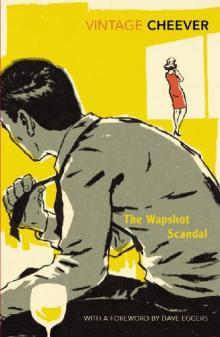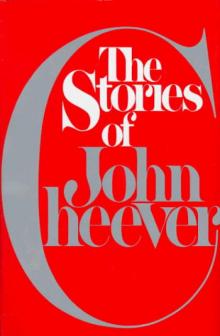- Home
- John Cheever
Scott Donaldson Page 2
Scott Donaldson Read online
Page 2
It hardly matters, except that it mattered to John Cheever. As he grew older, he became insistent on his father’s status as factory owner. But there is no mention of this part of his career in the apparently accurate story/article “The Autobiography of a Drummer,” which appeared in The New Republic of October 23, 1935. Its first-person account traces the roller-coaster career of a “commercial traveler” in the shoe business from 1891 to 1931. The unnamed salesman (or drummer) of the piece was modeled after his own father, Cheever acknowledged, and the pattern of success followed by failure was manifestly that of Frederick Lincoln Cheever’s life. Significantly, in the story the drummer fails through no fault of his own but because of changing economic conditions. In his glory days on the road—and this brief Cheever story anticipates Miller’s Death of a Salesman—the drummer succeeded through force of personality and the intimate knowledge of the business he’d acquired by going to work at twelve as office boy in a shoe factory. He “often sold two carloads of shoes over a glass of whiskey.” He “had ten suits of clothing and twenty pairs of shoes and two sailboats.” He gambled at the track and at the table. For three decades, from 1895 to 1925, he traveled all over the United States, living in hotels and clubs and selling “expensive and beautiful” shoes to individual buyers working “for individual firms.” But then the structure of the business began to change. Cheap shoes manufactured in mass quantities replaced well-crafted handmade shoes. Chain stores and stores owned by manufacturers replaced individually owned stores. Only a few independent dealers remained, and they did not buy enough to cover the expenses of selling shoes. By 1925 the drummer’s income began to drop; by 1930 he was out of work and as forgotten as “those big yellow houses with cornices and cupolas that they used to build.” Shaving in the morning, the salesman considers his life “a total loss.” He looks at his defeated face in the mirror, and then, he says in conclusion, “I get sick as if I had eaten something that didn’t agree with me and I have to put down the razor and support myself against the wall.”
This piece, signed like several other early writings by “Jon” Cheever, may have been shaped in part by the anticapitalist requirements of The New Republic in 1935. Politics aside, though, it accurately reflected what happened to Cheever’s father. By the mid-1920s his career had gone sour, while earlier there had been high old times on the road. Frederick Lincoln Cheever told stories about those days—about oyster sweepstakes in Chesapeake Bay, storms on Lake Erie, breakfasts in New Orleans, horse races and boxing matches and the night he and two companions drank all the champagne on the Boston–New York train. It was an extravagant life, but he brought back the orders.
Things were going well in 1900 when with thousands of others he shot off Roman candles in Boston Common to welcome the new century and decided, at thirty-seven, to get married. Projecting his own experience backward, John later reckoned that his father, “an intensely sensuous and perhaps lascivious man,” must have had affairs with lovers of both sexes during his bachelor years. In fact, his dapper father was regarded as something of a ladies’ man, though at least in the beginning he obviously adored the woman he married. This too would change; the marriage deteriorated along with the family fortunes.
A decade younger than her husband, Mary Devereaux Liley Cheever was born in England in 1873 and came to this country as a young girl with her parents, William and Sarah A. D. Liley. A tiny woman scarcely five feet tall, she was a dynamo of energy. John Cheever came to resent her, as many American male writers resent their strong mothers, but it was evidently from her side of the family that he inherited his artistic talent. Grandfather Liley died soon after the voyage across the Atlantic; Grandmother Liley survived to become a favorite figure of his boyhood. The daughter (according to her grandson) of Sir Percy Devereaux, a tradesman knighted by Victoria when he became Lord Mayor of Windsor, Sarah Liley began reading him Dickens in his preschool years; he reciprocated by reading to her after she suffered a stroke. She observed rigorous standards and demanded proper English of John. “Did you have a good time?” she would ask him. “An awful good time,” he would answer. And then she would say, “A very good time,” and he would say, “No, it was really an awful good time.” John’s father rather liked deflating her cultural pretensions. One afternoon she invited a pianist to tea. “Madame Langlois,” Frederick Cheever announced, “is about to tickle the ivories.”
Grandmother Liley knew how to let the air out of people too. She especially endeared herself to young John by describing his mother as “a little stupid and foolish.” That he always remembered, along with the Dickens. Well educated in England and capable of taking tea in French and hemming a pocket handkerchief, his grandmother nonetheless thought of herself as a free spirit. She read widely in current literature, and was a friend of Margaret Ware Deland, the Boston novelist and short-story writer. One day while walking with the Delands in the slums of Boston, she saw women rapping their rings against the windows. “Why are they doing that?” she asked. “Because they are whores,” Mr. Deland explained.
Left virtually destitute by the death of her husband, John’s maternal grandmother nonetheless managed to send her daughter Florence to art school. John’s aunt Florence, called Percy in the 1968 story he wrote about her, did eventually become a painter, though she was forced to abandon her dream of rivaling “the Masters of the Italian Renaissance” in favor of commercially salable magazine covers. She also smoked cigars (though remaining intensely feminine), and married a philandering doctor whom she continued to love despite his frequent amours. She transferred her artistic hopes to their son, Randall, who had a short career as a concert pianist. After Sunday dinner, Cheever irreverently recalled, Randall “would play two Beethoven sonatas … and everyone would sit around and belch.”
In a 1968 journal entry about “Percy,” Cheever chastises himself for any hint of affectation, any trace of a swagger, in the story. The real reason his Aunt Florence interested him was not that she smoked cigars—it was that art ruled her life as it came to rule his own. One of her last requests was to be taken from her sickbed to see the Sargent watercolors at the Boston Museum one final time.
The artistic inheritance of the Lileys bypassed John’s mother, but not the drive and enthusiasm behind it. Both for economic reasons and because it suited her personality, she rejected the Victorian role of passive housewife. Mary Liley Cheever was a woman who did things for others. After high school she attended the school of nursing at Massachusetts General Hospital; she became a head nurse there within a year following her graduation. She and Frederick Cheever must have met and fallen in love sometime during the late 1890s in Boston, where he had for many years been living with and supporting his mother. At the time Mary Liley was thought to be “quite beautiful.” In one photograph of her as a young woman that John recalled, she had fair hair, wore a long tennis dress, and carried a racket. “Her features had a pleasant, sensuous thickness.” She looked something like John himself at the same age. Another photograph he remembered characterized her better, however. This picture appeared on the cover of a luncheon program, celebrating Founders Day at the Quincy Woman’s City Club. She was one of the founders, or as John put it with some hyperbole, “she was founder.” In this picture of Mary Liley Cheever, now in her late thirties, the features were finer and the hair darker. These photographs have not survived. John’s mother did not like to have her picture taken. She had been able to achieve a look of composure in the Founders Day photo, she explained to her son, only by holding him in her lap. “I was cropped,” he added.
That rather bitter remark typified Cheever’s feelings about his mother. In his view she was too occupied in raising money for the new parish house, financing the library, installing flower boxes, starting progressive schools, and promoting cultural events to devote much time to him. She “always seemed to be out raising money … rather than being at home when I needed her.” Similarly she invited the downtrodden to take Thanksgiving dinner with the family, but had l
ittle time or inclination for mundane domestic tasks. She used to sing a lament about having to wash and iron a shirt, John recalled. Another song was “Hands Off.” When as in “Independence Day at St. Botolphs,” a draft for the opening of The Wapshot Chronicle, Sarah Wapshot (Mary Liley Cheever) came home “from a stirring lecture on hospital conditions,” she was in no mood to be embraced. Her husband blew down the back of her neck to no avail. Her “lack of interest in sexuality” sorted badly with his passionate nature. Nor was she demonstrative with her two sons. “There were very seldom warm embraces. Her rules of decorum were rigidly observed.”
In such an environment John Cheever grew up, in a series of three houses all located in Quincy, Massachusetts, the South Shore city—suburb to Boston—where his parents moved shortly after the birth of their first son, Frederick Jr., in 1905. As old as Boston itself, Quincy was best known for its most famous citizens. Specifically, Quincy was the home—at least in summer—of the Adams family: the two presidents John and John Quincy, then Charles Francis Adams and Brooks and Henry Adams. The name of a still earlier resident, Thomas Morton of Merry Mount, figures less prominently in histories of the community, for he brought infamy with him.
Morton arrived with Captain Wollaston to establish the original settlement in 1625, and upon Wollaston’s departure took over command. He set up an Indian trading post at Merry Mount, or Mount Wollaston (both place-names survive in modern Quincy), and conducted himself so recklessly as to call down the wrath of the other English settlements in the New World. A veritable lord of misrule, Morton got the Indians drunk before striking bargains with them, and then sold them guns. In addition, he and his men disported themselves with the Indian women, “the lasses in beaver coats,” around the community Maypole. The combination of “neglected Indian husbands, liquor, and gunpowder” threatened to lead to serious trouble, and eventually Miles Standish was dispatched from Plymouth to arrest Morton in the king’s name. Morton was deported to England, but soon returned to resume his former practices. The Massachusetts Bay Colony in the form of Governor Endicott then descended on Merry Mount to cut down the Maypole and ship the still-unchastened Morton back to England again, this time permanently. The rebellion of Thomas Morton, involving strong drink and promiscuity, was directed against the accepted mores of his time. The Adams family objected more discreetly and to political rather than social constraints, but they too rebelled against authority. “Resistance to something,” as Henry Adams wrote in his Education, “was the law of New England nature,” and this was true of John Cheever in the 1920s as it had been for Morton in the 1630s and Adams in the 1850s.
Henry Adams’s Quincy represented summertime relief from the rigors of winter in Boston. “Town was constraint, law, unity. Country, only seven miles away, was liberty, diversity, outlawry, the endless delight of mere sense impressions given by nature for nothing, and breathed by boys without knowing it.” For Cheever, seventy years later, these dual impulses toward freedom and confinement, license and law, nature and civilization fought their way out on the stony ground of Quincy itself. In its most concrete manifestation, he felt a “critical division” between his outdoor world of play and his mother’s indoor world of propriety.
The Quincy of his youth was larger and far more of a self-sufficient city than the rural retreat Henry Adams had enjoyed. It had grown by virtue of its twenty-seven miles of shoreline—young Henry could gaze from the hill near John and Abigail Adams’s Old House east across Quincy Bay, north to Boston and beyond—and on the strength of the granite industry. Quincy granite sales flourished from the mid-nineteenth to the early twentieth century. Scotch-Irish, Scandinavian, and Italian immigrants came to quarry and cut the granite. The large Fore River shipyard started operating in 1900, attracting still more laborers and managers. The old summer houses were converted to year-round use, as the railroad made commuting to Boston easy. Not all of the growth pleased longtime residents. More people meant more schools, more police, and higher taxes. The Adams family moved out as the Cheevers moved in.
CHILDHOOD
1912–1926
The Cheevers lived first in the flat part of Quincy, near the trolley tracks. It was there, in a small house at 43 Elm Avenue, that John William Cheever spent the first seven years of his life. He was born on May 27, 1912, almost seven years after Fred. There were no other children. John’s parents had not planned on his birth, as he was often to hear in the years ahead. His mother was thirty-nine, his father forty-nine when he was born.
Looking back on his youth in a 1978 interview, John Cheever said that it could be divided into an extremely sunny childhood and an extremely troubled adolescence. The childhood was probably not as happy as all that, however. His mother kept busy, and was not given to shows of affection. His father was often away from home on sales trips, and when in residence devoted substantially more time to John’s older brother, Fred, than to him. Fred was so much older that he and John could hardly have played together. Cheever remembered little of those first years. What he did remember suggests that things were less sunny than he stated publicly.
In his earliest recollections of his mother, she almost always appears as dominating if not tyrannical, cruel if not heartless. Much of the time, she was too busily occupied with charity projects and home-front war work to pay much attention to her younger son. Yet it was she who tore him from the arms of a maid he had grown fond of, as she fired her for petty thieving. And it was she who snatched the broom from him, with the exasperated comment that he “swept like an old woman.”
By 1920 the Cheevers had moved up the hill to Wollaston, Quincy’s solid Ward 5, the Republican stronghold, the best neighborhood in town. For two years they stayed in a two-family house at 396 Highland Avenue. By 1922, however, they were living in their own eleven-room home a few blocks away, at 123 Winthrop Avenue. The house was Victorian, and so was the heavy, comfortable furniture that Mary Liley Cheever installed. Weekdays John walked to Wollaston Grammar School, near the corner of Highland and Beale Street. On Sundays he attended Episcopal Sunday school. The family fortunes were at their peak. Father went off to work in Boston or Lynn, but rarely took long trips on the road. Mother became a clubwoman, a “Madame President.” Gentility reigned.
Wollaston in the early 1920s was “very much turn of the century.” Draft horses still clopped through the streets, bringing merchants and their wares. The milkman delivered before 5:00 A.M. You set a large square card in the window for the iceman, turned to indicate how much ice you wanted, twenty-five, fifty, seventy-five, or one hundred pounds. Children tagged along behind the ice wagon to cadge a free sample. Mr. Holman the vegetable man, famous for his high-stepping horse, stopped in at kitchens to sell housewives his products. He might have a special on “native grass” (asparagus) or on oyster shells to be spread on sidewalks. Hawkers toured the streets in open delivery trucks with roll-down side curtains in case it rained. “Strawbeeeries! Strawbe-e-e-ries! Forty cents a box,” they hollered, and the box held a quart. Junkmen came by with horse and wagon and a spring-operated hand scale to buy scrap metal and bundles of old newspapers. Kids from down the hill sometimes tossed stones or ripe fruit on the Baileys’ tennis court, but there was no serious crime. There were no minorities either, except for Jimmy Tab, who ran the bicycle shop and whose son was the only black child at Wollaston Grammar. Otherwise everyone was white and Christian and well-to-do. If anyone deviated from the norm in some way, it was noticed but discussed, if at all, quietly, quietly.
On the surface John Cheever seemed much like the other children on Wollaston hill. He played kick-the-can, hide-and-go-seek, hoist-the-green-sail, and nine-ten-red-light. He climbed the backyard pear tree he named the Duchess. He lost three teeth riding his brother’s bike without permission. He went fishing in the summer and skated in the winter. He swam naked in the woods beyond Furnace Brook Parkway. He loved swimming in the brook, in Black’s Creek, and in Quincy Bay off Wollaston Beach. Black’s Creek joins the sea at the south end
of the beach, and there, his friend Rollin Bailey distinctly remembers hearing, Cheever once threw a ring into the creek and “thus married the creek near where it married the ocean.” That was so curious a tale that Bailey stopped telling people about it. They didn’t believe it or couldn’t imagine such a gesture or didn’t know John Cheever anyway.
The theatricality of the gesture fitted Cheever’s boyhood personality even as it suggested a lack of emotional bonding within the family. Young Cheever spent much of his time in fantasy worlds. He loved playacting. On one Washington’s birthday, he saw to it that all the neighbor youngsters were outfitted in Revolutionary War regalia. As organizer he reserved the role of General Washington for himself. When others took over charge of neighborhood play, he was assigned less glamorous roles. In the Robin Hood band that Rollin Bailey organized, for instance, he was cast as Friar Tuck, and logically so. Like the good friar, he was roly-poly and affable.
When he was still in grade school, Cheever suffered an attack of pulmonary tuberculosis. His mother had the disease herself and may have communicated it to her son. Yet she neglected him in his distress, the boy thought, and he never forgave her. For a time thereafter, he became an indoor child and brought his fantasy world inside with him in the form of puppet shows. At their simplest these were performed in the attic for one or two other children. Sometimes there were more public presentations. The tiny theater with its colorful backdrop was his own creation. “He built his own puppet theater, designed the scenery, and dyed the materials for the costumes,” next-door neighbor Helen Howarth remembers. She was enlisted to sew the costumes, advertise the shows, and take in pennies and safety pins. Then John would take over. “He did the talking (in appropriate voices for the characters), manipulating them and narrating the story themes before the acts.”

 The Wapshot Scandal
The Wapshot Scandal The Stories of John Cheever
The Stories of John Cheever Bullet Park
Bullet Park Falconer
Falconer The Journals of John Cheever
The Journals of John Cheever Oh What a Paradise It Seems
Oh What a Paradise It Seems Scott Donaldson
Scott Donaldson The Wapshot Chronicle
The Wapshot Chronicle The Stories of John Cheever (1979 Pulitzer Prize)
The Stories of John Cheever (1979 Pulitzer Prize)